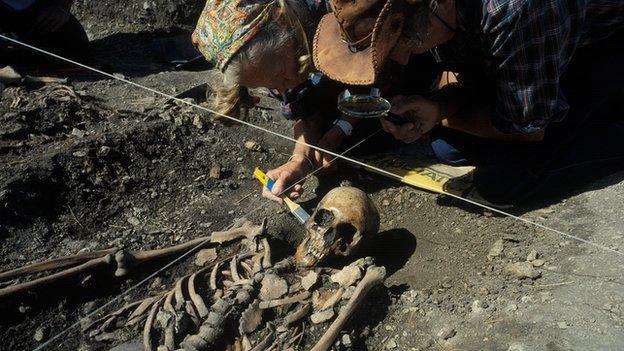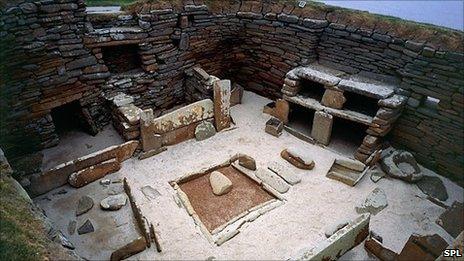Farming 'spread by migrant wave'
- Published

The researchers extracted DNA from 5,000-year-old remains found in southern Sweden
A new study of DNA from ancient remains provides further evidence that farming was first spread to Europe by migrants.
It casts doubt on the alternative theory in which agriculture was adopted by Europe's existing hunter-gatherer populations, spreading via cultural exchange with neighbouring tribes.
<link> <caption>Science journal says</caption> <url href="http://www.sciencemag.org/content/336/6080/466" platform="highweb"/> </link> a team compared DNA from the skeleton of an ancient farmer with that from three hunters.
They found the "farmer" was genetically distinct from hunters.
Pontus Skoglund, from Uppsala University, Sweden, and colleagues extracted genomic DNA (genetic material contained in the nucleus of cells) from the 5,000-year-old remains unearthed in southern Sweden.
Ensuring the DNA obtained from these remains was genuinely ancient and uncontaminated by modern DNA required the team to use advanced molecular and statistical techniques.
They compared the genetic profiles of the stone age (Neolithic) farmer and contemporary hunter gatherers with those of modern populations.
Although the female farmer appears to have been born in the region, her genetic make-up was most similar to that of modern people from south-east Europe.
This would be consistent with evidence from archaeology, which posits a spread of agriculture from Anatolia (modern Turkey) towards the north and west of Europe after 8,000 years ago.
Meanwhile, the hunter-gatherers did not match any living group well but their DNA most closely resembled that of present-day Finnish people.
The researchers say their research supports the idea that the agricultural revolution was driven by people who migrated from southern Europe.
Later transition
The extent to which the continent's present-day inhabitants are descended from these early farmers versus the indigenous hunter-gatherers who settled the continent thousands of years previously is a matter of debate.
The results vary depending on the scientific approaches used and are subject to differing interpretations.

Skara Brae, in the Orkneys, displays the sophistication of some farming groups
"We have been able to show that the genetic variation of today's Europeans was strongly affected by immigrant stone age farmers, though a number of hunter-gatherer genes remain," said co-author Anders Gotherstrom, also from from Uppsala University.
But a study <link> <caption>published this week in Plos One journal</caption> <url href="http://www.plosone.org/article/info:doi/10.1371/journal.pone.0034417" platform="highweb"/> </link> compared the mitochondrial DNA of hunters and farmers in northern Spain, and hints at a more complex picture of settlement.
Dr Wolfgang Haak, from the University of Adelaide in Australia, who was not involved in the research, told BBC News the number of samples in the Swedish research were "certainly not enough to explain the process of Neolithisation in all detail in every corner of Europe, especially since the Neolithic transition in southern Scandinavia is happening much later than in southern parts of Europe.
"However, it gives a good indication as far as the two most extreme models are concerned, with demic diffusion (expanding farmers) on one side and a strict cultural diffusion (transfer of ideas) on the other."
Prof Cristian Capelli, from the University of Oxford, UK, called the study "a good start", adding: "The quality of the information gathered from ancient DNA is now making possible to explore genetic information beyond a single locus (such as mitochondrial DNA, from the cell's powerhouses), offering insights on the genomic variation of individuals from the past."
Go mingle
The authors of the Science study propose that the incoming farmers lived side-by-side with the hunter-gatherers for many generations and eventually interbred.
They further suggest that interbreeding between groups like those represented in the study can explain the patterns of genetic variation seen in modern Europeans.
But other researchers were not totally convinced. Prof Capelli commented: "My feeling is that some degree of differentiation among European populations had been present even before the arrival of the farmers.
"The effect of drift on small hunting bands with low density might have had a significant impact on the differentiation between groups well before the dispersal of agriculture in Europe."
Dr Haak commented: "While we still lack evidence from West and South European sites we have to assume that these share characteristics similar to their northern neighbours, which is likely due to a relatively recent re-expansion of hunter-gatherers from refugia in Southern Europe after the last [Ice Age].
"Having said that, my experience shows that we're always in for a surprise in ancient DNA. By and large, the process of Neolithisation was certainly a very complex and by no means a uniform one. We therefore need many more samples from both hunter-gatherers and earliest farmers from different regions to be able to describe the changes in the genetic landscape during the Neolithic transition."
- Published24 August 2011
- Published10 November 2010